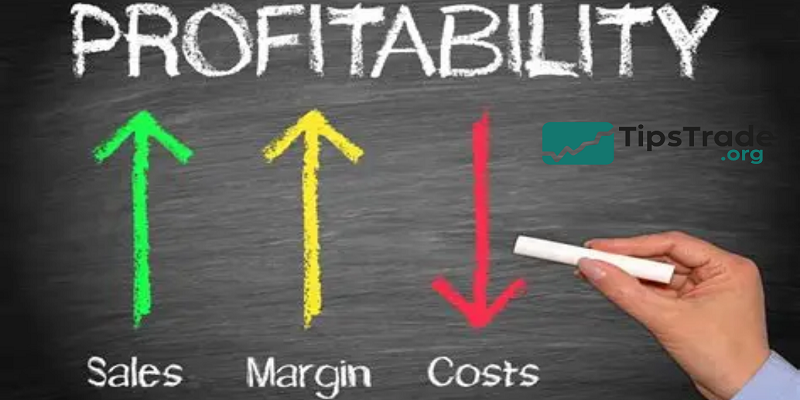Profitable forex strategies are essential for traders aiming to consistently succeed in the competitive currency markets. Profitable forex strategies combine technical analysis, risk management, and market understanding to maximize gains and minimize losses. This article highlights some of the most effective and widely-used profitable forex strategies in 2025 to help traders boost their performance.
Understanding Profitability Forex

- Profitability in forex trading goes beyond simply winning trades. It refers to sustainable performance over time, measured by consistency, risk-adjusted returns, and capital preservation.
- A trader with a 60% win rate but poor risk management may still lose money, while another with a 40% win rate and strong risk/reward ratios may be highly profitable.
- In practice, forex profitability depends on balancing three elements: strategy, psychology, and money management.
- For example, a profitable scalper might earn small but frequent profits using a disciplined system, while a swing trader may hold fewer trades but achieve higher gains per position.
- Recognizing what profitability means in context helps traders set realistic goals and avoid chasing unrealistic expectations.
>>Read more:
- What is Forex? The Complete Guide for Beginners
- Important Economic Indexes Every Trader Needs To Know
- The Impact of Central Bank vs Forex – Understand to Invest Effectively
- News Trading Forex Strategies for Beginners
The Role of Risk Management in Profitability
- Risk management is the backbone of any profitable forex strategy. Position sizing, stop-loss orders, and appropriate use of leverage all determine whether a strategy will generate sustainable profits.
- For example, if two traders both win 50% of their trades, but one risks 5% per trade and the other risks only 1%, their long-term results will differ dramatically.
- The second trader has a better chance of staying in the market long enough to achieve profitability.
- Research from the CFA Institute highlights that capital preservation is as important as profit generation.
- Real-world traders often share stories of blowing accounts by ignoring risk rules, which reinforces the lesson that no strategy is profitable without disciplined risk control.
Characteristics of Profitable Forex Strategies
- While no single “holy grail” exists, profitable forex strategies share common characteristics.
- First, they are simple and easy to follow, avoiding unnecessary complexity. Second, they are consistent, meaning they work across different market conditions when applied correctly.
- Third, they are adaptable, allowing traders to adjust to evolving trends, volatility, and news events.
- Finally, they always integrate risk control.
- For example, a trend-following strategy using moving averages works not because it predicts the future, but because it provides a repeatable framework with defined rules.
- A profitable strategy is less about perfection and more about discipline and repeatability, which helps traders withstand the ups and downs of the forex market.
Technical vs Fundamental Approaches
- Profitable forex strategies can be technical, fundamental, or a combination of both.
- Technical strategies rely on chart patterns, indicators, and price action, making them popular for short-term traders.
- Fundamental strategies, on the other hand, analyze macroeconomic factors like interest rates, inflation, and GDP data, which drive long-term currency trends.
- Each approach has advantages.
- Technical methods provide precise entry and exit points, while fundamentals explain the broader direction of the market.
- For example, a trader might use fundamental analysis to identify that the USD is strengthening due to Federal Reserve rate hikes, but rely on technical tools to pinpoint the best entry.
- Successful traders often combine both approaches for maximum profitability.
Top Profitable Forex Strategies Explained

Trend Following Strategy
- Trend following is one of the most time-tested profitable forex strategies. It is based on the idea that prices tend to move in sustained directions due to underlying economic forces.
- Traders use moving averages, MACD, or trendlines to identify the prevailing direction and enter trades in that direction.
- For example, when the 50-day moving average crosses above the 200-day moving average (the “Golden Cross”), it signals a potential uptrend.
- Professional traders like Richard Dennis built fortunes by following trends in different markets, proving that this approach works when applied with discipline.
- The key is to ride the trend while managing risk, rather than attempting to predict reversals.
Breakout Trading Strategy
- Breakout trading focuses on capturing profits when price moves beyond established support or resistance levels.
- This strategy works well in volatile conditions when markets consolidate before making sharp moves.
- Traders use tools like Bollinger Bands, ATR, and volume indicators to confirm breakouts.
- For example, if EUR/USD consolidates near 1.1000 and then breaks above with high volume, a breakout trader enters long.
- While breakouts can deliver large profits quickly, they require strict stop-loss rules to avoid false breakouts.
- Many successful traders share their experiences of combining breakout setups with news events like central bank announcements to increase profitability.
Range Trading Strategy
- Range trading works in sideways markets where price oscillates between support and resistance. Traders use oscillators like RSI and Stochastic to identify overbought or oversold conditions.
- For example, if GBP/USD has been bouncing between 1.2500 and 1.2700, a range trader sells near resistance and buys near support.
- This strategy is popular among beginners because it is straightforward, but it requires patience and careful monitoring of market conditions.
- A sudden news event can break the range, turning a profitable setup into a loss.
- Therefore, traders must apply tight risk management when using this approach.
Scalping Strategy
- Scalping is a high-frequency strategy that aims to capture small profits from minor price movements.
- Scalpers may place dozens of trades per day, relying on fast execution and low spreads.
- This strategy requires a broker with tight spreads (ECN accounts are preferred) and powerful trading platforms.
- For example, a scalper may trade EUR/USD with a 2-pip target repeatedly during the London session.
- While scalping can be profitable, it demands discipline, focus, and emotional control. Many traders find scalping stressful but rewarding if combined with strict rules and risk limits.
Swing Trading Strategy
- Swing trading is a medium-term strategy where trades are held for several days to weeks.
- It combines elements of both technical and fundamental analysis. Swing traders aim to capture larger price moves than scalpers, but without committing to long-term positions.
- For instance, a swing trader might buy AUD/USD after a bullish reversal pattern supported by strong employment data.
- This strategy is popular among part-time traders because it requires less screen time compared to day trading.
- With proper analysis and discipline, swing trading can deliver consistent profitability while avoiding the stress of short-term fluctuations.
News Trading Strategy
- News trading seeks to profit from sharp market movements triggered by economic announcements.
- Events like Non-Farm Payrolls (NFP), central bank interest rate decisions, or inflation reports often cause high volatility.
- For example, if the Federal Reserve unexpectedly raises rates, the USD typically strengthens immediately.
- News traders attempt to anticipate or react quickly to such events. While the rewards can be significant, risks are equally high due to slippage and sudden reversals.
- Many traders share real experiences of both big wins and devastating losses from news trading, emphasizing that preparation and risk control are essential for profitability.
Advanced Profitable Forex Strategies

Algorithmic & EA Trading
- Algorithmic trading and Expert Advisors (EAs) have become increasingly popular. These strategies use pre-programmed rules to execute trades automatically, removing emotional biases.
- For example, an EA might be programmed to buy EUR/USD when the RSI drops below 30 and sell when it rises above 70.
- Algorithmic trading dominates institutional forex trading, with studies showing that over 60% of trades are executed algorithmically.
- While EAs can be profitable, they require backtesting, optimization, and ongoing monitoring to remain effective in changing market conditions.
Hedging Strategies
- Hedging is used to reduce risk by opening offsetting positions. For example, a trader long EUR/USD might hedge by shorting GBP/USD, given their positive correlation.
- Hedging helps protect profits or limit losses during uncertain conditions. While not always aimed at direct profitability, effective hedging ensures long-term survival,
- which is critical for achieving overall profitability. Many professional traders use hedging during periods of extreme volatility, such as before major geopolitical announcements.
Carry Trade Strategy
- The carry trade involves borrowing in a low-interest currency and investing in a higher-yielding one.
- For example, borrowing Japanese yen at near-zero rates and buying Australian dollars with higher yields can generate profits from interest rate differentials.
- This strategy was highly profitable before the 2008 financial crisis and remains relevant when interest rate gaps are wide.
- However, it carries risks if currency prices move against the position.
- Traders using carry trades must monitor global economic trends carefully to stay profitable.
Mistakes Traders Make When Looking for Profitable Strategies
- Many traders fail not because their strategies are bad, but because of common mistakes.
- Over-leveraging is one of the most frequent errors, leading to rapid account wipeouts. Strategy hopping is another problem; traders abandon strategies too quickly after a few losses, preventing them from realizing long-term potential.
- Ignoring backtesting or demo testing often results in deploying unproven strategies in live markets.
- Finally, emotional trading—fear, greed, and impatience—undermines even the most profitable strategies. A profitable strategy requires consistency and discipline, qualities that separate successful traders from the majority.
How to Choose the Right Strategy for You
- Not every strategy suits every trader. Choosing the right one depends on factors like trading capital, risk tolerance, time availability, and personality.
- For example, a part-time trader with a full-time job may find swing trading more suitable, while a full-time trader might prefer scalping.
- Beginners are often advised to start with simple strategies like range trading before progressing to advanced methods like algorithmic trading.
- The best strategy is one that aligns with your lifestyle and allows you to trade consistently without emotional stress.
Building and Backtesting a Profitable Forex Strategy

- A profitable strategy must be built, tested, and refined before being used live. Backtesting on platforms like MT4, MT5, or TradingView helps traders see how their strategies perform on historical data.
- Forward testing on demo accounts ensures they work in real market conditions.
- For example, a trader may design a moving average crossover strategy, backtest it over 10 years of data, then forward test it for three months before going live.
- Without backtesting and forward testing, traders risk relying on unproven systems, which often leads to losses.
Case Studies – Real Examples of Profitable Forex Strategies
- Case 1: The Disciplined Swing Trader – A trader documented on Myfxbook achieved steady 15% annual returns by sticking to a swing trading strategy and risking only 1% per trade.
- Case 2: The Scalper – A professional scalper shared on ForexFactory that he turned $10,000 into $40,000 in 18 months by scalping EUR/USD with strict risk management.
- Case 3: The News Trader – A news trader successfully profited during Brexit volatility by preparing in advance with hedges and reduced leverage.
These cases demonstrate that profitability comes in different forms, but always with discipline and consistency.
Conclusion
Profitable forex strategies are not about luck or quick gains. They are about consistency, discipline, and risk management. From trend following to scalping, news trading to algorithmic strategies, each approach offers opportunities if applied with patience and a clear plan. Traders who treat forex like a business, manage risks carefully, and commit to continuous learning are the ones most likely to achieve long-term profitability.
Read more:

